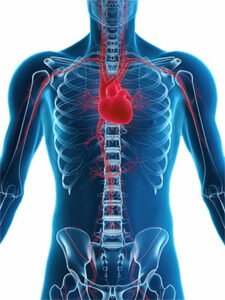Abdominal Aortic Aneurysm
The aorta is the largest blood vessel in the human body. It is responsible for carrying blood from the heart up to the brain and down to the abdomen, legs, and pelvis. Under certain conditions, if the walls of the aorta become weak, they can swell or bulge out, similar to a small balloon. When this bulging occurs in the walls of the aorta that is located in the abdomen, it is known as an abdominal aortic aneurysm (AAA).
Every year 200,000 people in the US are diagnosed with an abdominal aortic aneurysm. AAA’s can sometimes be minor with little adverse health effects, but if the aneurysm ruptures, it can be life-threatening. A ruptured AAA is the 15th leading cause of death in the US, and the 10th leading cause of death in men older than 55. Aneurysms run in families, with the likelihood of developing an AAA being 12 times greater if you have a first-degree relative with aneurysm history.
AAA are classified by their size and speed at which they are growing. The larger the size and the faster the rate of growth, the more likely that it will need to be treated with surgery. After being diagnosed with an aneurysm, your doctor will want to monitor you closely. By being knowledgeable about the risk factors, symptoms, and treatment options, you can prepare yourself to understand your diagnoses and what actions need to be taken.

Abdominal Aortic Aneurysm Causes
Many factors can contribute to the development of an AAA. The weakening of the walls of the aortic artery can be caused by inflammation, damage in the arterial wall, infection, and congenital connective tissue disorders. Certain circumstances can result in a greater likelihood of the formation of an AAA.
- Men over the age of 60
- Smoking and tobacco use
- Caucasian
- A first-generation relative with a diagnosis
- Personal history of atherosclerosis
- High blood pressure
- Elevated cholesterol
- Heart or peripheral vascular disease
Abdominal Aortic Aneurysm Symptoms
In most cases of abdominal aortic aneurysms cause no system and are usually discovered when the person is being evaluated for another medical condition.
Sudden, severe abdominal or back pain is a symptom that should be taken seriously if the person has a family history of AAA. This could be a sign the person has developed an AAA, and the pain could be the result of this aneurysm is in the process of rupturing.
A small percentage of people diagnosed with AAA have pain, discolored skin, and sores on their feet and toes. This is sometimes caused when plaque or blood clots from elsewhere in the body collect in the feet and toes.
Diagnosing Abdominal Aortic Aneurysm
Most AAAs cause no symptoms and are discovered during a different medical examination. If a person is diagnosed with an AAA, their doctor will refer them to a vascular surgeon.
Imagining tests are used to determine the size and rate of growth of the aneurysm. An abdominal ultrasound is commonly used to determine this and is painless, cost-effective, and safe.
Another test used is called a computed tomographic angiography (CTA). It can assess the size, location, and extent of the impact of the aneurysm. While this test requires exposure to radiation and an injection of an intravenous contrast agent, it will provide a vascular surgeon with valuable anatomic information about the aneurysm and the best way to approach its repair.
Abdominal Aortic Aneurysm Treatment
The treatment of an AAA will depend on its size.
A small or slow-growing AAA is defined as being less than 5.5 centimeters. An aneurysm this size has a much lower risk of rupturing than a larger aneurysm. A doctor will most likely consider it to be safer to monitor this type with regular abdominal ultrasounds, rather than to treat it with surgery. It is crucial to have an ultrasound every 6-12 months. Lifestyle changes such as quitting smoking, controlling blood pressure, and daily exercise can also be beneficial and lower your risk for rupture.
A larger or fast-growing AAA is defined as being greater than 5.5 centimeters. An aneurysm of this size is much more likely to rupture, which can lead to internal bleeding and other serious medical complications. There are two different surgeries used to repair a large AAA. One is open surgery, which requires the placement of a prosthetic graft through an incision in the abdomen. Most patients need to stay in the hospital for 4-10 days after this type of surgery. Recovery time is expected to be up to 3 months. The second type of surgery is an endovascular aneurysm repair (EVAR). An EVAR is a less invasive treatment and involves two small incisions in the groin. Guided by x-ray imaging, a vascular surgeon will insert a tiny device into the artery to reinforce the aortic wall. Most people can recuperate quickly from this and will only need to stay in the hospital for 1-3 days with this type of treatment, and recovery time is expected to be shorter than with open surgery.
Prevention
While an abdominal aortic aneurysm can be fatal if it ruptures, there are effective treatments to prevent this from happening. The weakening of the artery walls, which leads to the development of an AAA, can be caused by genetics, but some steps can be taken to reduce your risk. Staying healthy and active can contribute significantly to your overall health. Maintaining a healthy weight can be achieved through regular exercise and a heart-healthy diet that is low in sodium. Also, you can have your blood pressure and cholesterol checked regularly to keep a note of any negative trends. Your doctor can evaluate your need to be on any medications to control your blood pressure or lower your cholesterol levels. Also, if you currently smoke, your doctor can help you find a smoking cessation program.
It is essential to be knowledgeable about your family history. If you are diagnosed with an AAA, it is advisable to let your relatives know so they, too, can take the proper steps to take control of their health and be knowledgeable of their higher chance.
